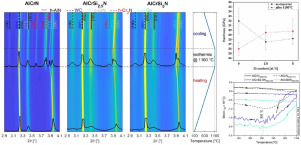当前位置:
X-MOL 学术
›
Acta Mater.
›
论文详情
Our official English website, www.x-mol.net, welcomes your
feedback! (Note: you will need to create a separate account there.)
Microstructural evolution and thermal stability of AlCr(Si)N hard coatings revealed by in-situ high-temperature high-energy grazing incidence transmission X-ray diffraction
Acta Materialia ( IF 8.3 ) Pub Date : 2020-03-01 , DOI: 10.1016/j.actamat.2020.01.026 N. Jäger , M. Meindlhumer , S. Spor , H. Hruby , J. Julin , A. Stark , F. Nahif , J. Keckes , C. Mitterer , R. Daniel
Acta Materialia ( IF 8.3 ) Pub Date : 2020-03-01 , DOI: 10.1016/j.actamat.2020.01.026 N. Jäger , M. Meindlhumer , S. Spor , H. Hruby , J. Julin , A. Stark , F. Nahif , J. Keckes , C. Mitterer , R. Daniel

|
Abstract An extensive understanding about the microstructural evolution and thermal stability of the metastable AlCr(Si)N coating system is of considerable importance for applications facing high temperatures, but it is also a challenging task since several superimposed processes simultaneously occur at elevated temperatures. In this work, three AlCr(Si)N coatings with 0 at%., 2.5 at% and 5 at% Si were investigated by in-situ high-temperature high-energy grazing incidence transmission X-ray diffraction (HT-HE-GIT-XRD) and complementary differential scanning calorimetry and thermogravimetric analysis measurements combined with conventional ex-situ X-ray diffraction. The results revealed (i) a change in the microstructure from columnar to a fine-grained nano-composite, (ii) a reduced decomposition rate of CrN to Cr2N, also shifted to higher onset temperatures from ~ 1000 ∘C to above ~ 1100 ∘C and (iii) an increase of lattice defects and micro strains resulting in a significant increase of compressive residual strain with increasing Si content. While the Si-containing coatings in the as-deposited state show a lower hardness of 28 GPa compared to AlCrN with 32 GPa, vacuum annealing at ~ 1100 ∘C led to an increase in hardness to 29 GPa for the coatings containing Si and a decrease in hardness to 26 GPa for AlCrN. Furthermore, the in-situ HT-HE-GIT-XRD method allowed for simultaneously accessing temperature-dependent variations of the coating microstructure (defect density, grain size), residual strain state and phase stability up to ~ 1100 ∘C. Finally, the results established a deeper understanding about the relationships between the elemental composition of the materials, the resulting microstructure including crystallographic phases and residual strain state, and the coating properties from room temperature up to ~ 1100 ∘C.
中文翻译:

原位高温高能掠入射透射 X 射线衍射揭示 AlCr(Si)N 硬质涂层的微观结构演变和热稳定性
摘要 对亚稳态 AlCr(Si)N 涂层体系的微观结构演变和热稳定性的广泛了解对于面临高温的应用具有相当重要的意义,但由于在高温下同时发生多个叠加过程,这也是一项具有挑战性的任务。在这项工作中,通过原位高温高能掠入射透射 X 射线衍射 (HT-HE-GIT) 研究了三种含 0 at%、2.5 at% 和 5 at% Si 的 AlCr(Si)N 涂层-XRD) 和互补差示扫描量热法和热重分析测量与传统的非原位 X 射线衍射相结合。结果表明 (i) 微观结构从柱状变为细粒纳米复合材料,(ii) CrN 到 Cr2N 的分解速率降低,也转移到更高的起始温度,从~1000 ∘C 到~1100 ∘C 以上和(iii)晶格缺陷和微应变的增加导致压缩残余应变随着 Si 含量的增加而显着增加。虽然沉积态的含 Si 涂层的硬度低于 28 GPa 的硬度,但与具有 32 GPa 的 AlCrN 相比,在 ~ 1100 ∘C 下真空退火导致含 Si 涂层的硬度增加至 29 GPa 并降低对于 AlCrN,硬度可达 26 GPa。此外,原位 HT-HE-GIT-XRD 方法允许同时访问涂层微观结构(缺陷密度、晶粒尺寸)、残余应变状态和相稳定性高达 ~ 1100 ∘C 的温度相关变化。最后,
更新日期:2020-03-01
中文翻译:

原位高温高能掠入射透射 X 射线衍射揭示 AlCr(Si)N 硬质涂层的微观结构演变和热稳定性
摘要 对亚稳态 AlCr(Si)N 涂层体系的微观结构演变和热稳定性的广泛了解对于面临高温的应用具有相当重要的意义,但由于在高温下同时发生多个叠加过程,这也是一项具有挑战性的任务。在这项工作中,通过原位高温高能掠入射透射 X 射线衍射 (HT-HE-GIT) 研究了三种含 0 at%、2.5 at% 和 5 at% Si 的 AlCr(Si)N 涂层-XRD) 和互补差示扫描量热法和热重分析测量与传统的非原位 X 射线衍射相结合。结果表明 (i) 微观结构从柱状变为细粒纳米复合材料,(ii) CrN 到 Cr2N 的分解速率降低,也转移到更高的起始温度,从~1000 ∘C 到~1100 ∘C 以上和(iii)晶格缺陷和微应变的增加导致压缩残余应变随着 Si 含量的增加而显着增加。虽然沉积态的含 Si 涂层的硬度低于 28 GPa 的硬度,但与具有 32 GPa 的 AlCrN 相比,在 ~ 1100 ∘C 下真空退火导致含 Si 涂层的硬度增加至 29 GPa 并降低对于 AlCrN,硬度可达 26 GPa。此外,原位 HT-HE-GIT-XRD 方法允许同时访问涂层微观结构(缺陷密度、晶粒尺寸)、残余应变状态和相稳定性高达 ~ 1100 ∘C 的温度相关变化。最后,











































 京公网安备 11010802027423号
京公网安备 11010802027423号